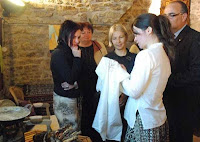Batik is probably the most famous of the resist methods of dyeing cloth. Resist dyeing involves applying a substance that stops dye from reaching certain parts of the fabric in order to create a pattern.

 This method can use wax (as in Javanese batik), rice paste (Japanese tsutsugaki) or can tie off a section of the fabric ('tie-dye' or Indian bandhani). In most parts of South-East Asia, the wax is applied using a copper spout allowing the craftsman to create intricate patterns and differing width of line. New areas of wax can be applied and the cloth which is usually cotton or silk, can be re-dyed allowing for greater complexity in design and color. After the design and coloration are finished the wax is removed and the cloth is ready for use. These traditional methods of creating batik are extremely time-consuming and require a high level of skill so various labor-saving devices have been introduced to the process including brushes for the wax and copper stamps that apply the wax. Any hand-produced batik takes a long time and can be very costly, so much of modern batik cloth is in fact batik print, retaining the patterns and colors of batik but without using the wax dying technique.
This method can use wax (as in Javanese batik), rice paste (Japanese tsutsugaki) or can tie off a section of the fabric ('tie-dye' or Indian bandhani). In most parts of South-East Asia, the wax is applied using a copper spout allowing the craftsman to create intricate patterns and differing width of line. New areas of wax can be applied and the cloth which is usually cotton or silk, can be re-dyed allowing for greater complexity in design and color. After the design and coloration are finished the wax is removed and the cloth is ready for use. These traditional methods of creating batik are extremely time-consuming and require a high level of skill so various labor-saving devices have been introduced to the process including brushes for the wax and copper stamps that apply the wax. Any hand-produced batik takes a long time and can be very costly, so much of modern batik cloth is in fact batik print, retaining the patterns and colors of batik but without using the wax dying technique.
 The vital influence batik has on the cultural life of Indonesia has been recognized by UNESCO which in 2009 declared Indonesian batik as part of the Intangible Cultural Heritage of Humanity: a living, cultural tradition, closely linked with the local community. UNESCO acknowledges Indonesian batik as a craft '...intertwined with the cultural identity of the Indonesian people and, through the symbolic meaning of its colors and designs, expresses their creativity and spirituality.'
The vital influence batik has on the cultural life of Indonesia has been recognized by UNESCO which in 2009 declared Indonesian batik as part of the Intangible Cultural Heritage of Humanity: a living, cultural tradition, closely linked with the local community. UNESCO acknowledges Indonesian batik as a craft '...intertwined with the cultural identity of the Indonesian people and, through the symbolic meaning of its colors and designs, expresses their creativity and spirituality.' 
 Young, fashion-conscious people are increasingly turning to batik shirts, dresses and scarves for casual wear, batik is increasingly popular for a number of social occasions such as weddings, as well as retaining its importance for cultural ceremonies, and batik is making its way onto the cat-walks and stores of top international fashion designers. It is increasingly popular worldwide too, and is used for furnishing, decorative purposes, tablecloths, and as a medium for painting and other artworks.
Young, fashion-conscious people are increasingly turning to batik shirts, dresses and scarves for casual wear, batik is increasingly popular for a number of social occasions such as weddings, as well as retaining its importance for cultural ceremonies, and batik is making its way onto the cat-walks and stores of top international fashion designers. It is increasingly popular worldwide too, and is used for furnishing, decorative purposes, tablecloths, and as a medium for painting and other artworks.








